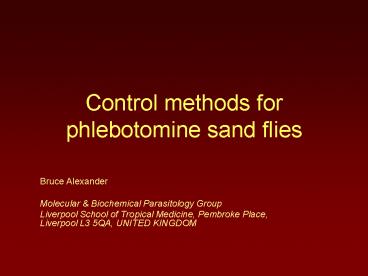Control methods for phlebotomine sand flies PowerPoint PPT Presentation
1 / 30
Title: Control methods for phlebotomine sand flies
1
Control methods for phlebotomine sand flies
- Bruce Alexander
- Molecular Biochemical Parasitology Group
- Liverpool School of Tropical Medicine, Pembroke
Place, Liverpool L3 5QA, UNITED KINGDOM
2
Types of vector control
- Chemical
- Biological/Microbial
- Genetic modification
- Environmental manipulation
3
Personal protection methods
- Repellents
- Protective clothing
- Mosquito nets/curtains
4
Chemical control
- Many New World foci of CL associated with
forested areas, control of sand flies not
considered practical - In urban areas spraying programmes may be carried
out using residual insecticides - Sand flies susceptible to all major groups of
insecticides but pyrethroids normally used
5
Spraying house with residual pyrethroid
insecticide
6
Cone test determining whether the residual
insecticide on a wall still kills sand flies
7
Limitations of chemical control
- Costly to carry out spraying programmes,
- especially when other vector-borne diseases
need to be controlled in same area (e.g. dengue) - Resistance to insecticides not a problem, except
in India (DDT resistance in P. argentipes) - Where to spray animal shelters? Within 200m
radius of cases?
8
Arrival of dengue in South America now 2 urban
vector-borne diseases competing for public health
budget
9
Chicken houses - to spray or not to spray?
- Not spraying chicken houses would save money and
deflect all infected sand flies towards chickens,
reducing number of infective bites(?) - Use chicken houses as foci of control measures?
10
Fluorescent powders for mark-release-recapture
studies
11
Mark-release-recapture procedure
- Catch sand flies by direct aspiration (e.g. in
Shannon trap or on host) - Count and introduce into container with
fluorescent dust - Release at site
- Attempt to recapture by various methods in
following days
12
Mark-release-recapture procedure information
that can be gained
- Gives some idea of distance that can be
potentially travelled (4km in Central Asia, 2.2km
in Brazil, 1km in Colombia) - Gives some idea of age sand flies can reach in
nature 3 weeks in France - Host loyalty?
13
Mark-release-recapture procedure limitations
- 1. Area to be reviewed increases
considerably with distance from release point,
requiring more times, traps and/or personnel - Species, age and physiological status of insects
at release not known (lab-reared flies may not
behave in same way) - Recapture rate generally low (about 1)
- Insects stressed by capture and marking?
14
Alternatives to institutionalised spraying
programmes individual or community-based control
- Mosquito nets (personal protection)
- Insecticide-treated nets (control?)
- Long-lasting, ready-impregnated nets (more
sustainable?) - Environmental manipulation
15
Mosquito nets - Considerations
- Untreated nets require very fine mesh to keep out
sand flies (owner discomfort/claustrophobia) - Treating nets at community level requires
investment in insecticide, regular re-treatment,
adequate disposal of waste chemical - Long-lasting, ready-impregnated nets more
expensive useless after 20 washes - Insecticide resistance already in mosquitoes and
bedbugs
16
Insecticide-impregnated mosquito net
17
Curtains/Sand fly-proofing house Impossible??!!
ITNs the only solution here!
18
Environmental manipulation - barrier zones
- Chop down all trees (potential sand fly resting
sites) within 200m radius of village - Kill any potential reservoir species
- Apply insecticide to cleared area
- - Esterre et al., (1986) in French Guiana
19
Barrier zones - the drawbacks
- Cleared land will be used to build houses or grow
crops.and will have to be extended outwards - Who pays for insecticides? Where and when are
these applied? - And by whom??
20
Painting tree trunk with whitewash to make it
unsuitable as a sand fly resting site
21
Virtual barrier zone -1
- Create cordon sanitaire around village
- Resting site trees treated with whitewash (not
residual insecticide) to make them unsuitable - Doesnt kill sand flies but makes them stay
further away from village less chance of
man-vector contact
22
Virtual barrier zone - 2
- Whitewash cheap and safe
- Anybody can apply it
- Already widely used to deter leaf-cutter ants
- Establishes boundaries of village
- No trees cut down continue to provide fruit,
shade - Easy to see when needs to be upgraded
- BUT
- Never tested in the field (yet!)
23
Repellents
- Stop sand flies biting
- Based on diethyltoluamide
- (DEET), citronella or other plant extracts
- Expensive, short term only for temporary
exposure (soldiers, tourists) - Neurotoxic effects (DEET), skin problems
- May react with plastics
24
Nopikex, a repellent soap containing DEET and
permethrin
25
Tested in the field by the Colombian army
unfortunately soap found to have no residual
effect if rinsed off
26
Scalibor - Insecticidal dog collars
27
Advantages - disadvantages
- Treated with deltamethrin
- Repel and kill sand flies under controlled
conditions - Spread over entire skin in 48h
- Only effective for 6 months (must be replaced)
- Effective for well-cared for pets, useless for
stray dogs - Relatively expensive
28
Larval breeding sites usually difficult to find
but P. argentipes breeds in cattle shelters. Bt
or neem leaves could be tried
29
Summary-1
- Sand flies susceptible to all major insecticide
groups - Larval breeding sites difficult to locate -
control by larvicides generally not an option
(but see P. argentipes) - Adults move by hopping across surfaces prior to
biting so vulnerable to residual (contact)
insecticides - VL (sand fly) control may have been unexpected
consequence of anti-malaria programmes
30
Summary-2
- Few indications of insecticide resistance (yet)
- Mosquito nets offer personal protection or
control at community/individual level - Environmental manipulation should be considered
in many situations

